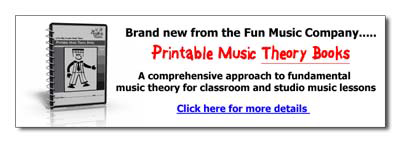“Research shows a positive connection between teachers’ preparation in their subject matter and their performance and impact in the classroom” .
I read this recently in a US study about teacher preparation research(1) and I’m sure that it’s no surprise to any of us that the more prepared a teacher is in their specific subject area(s) the more effective they will be as a teacher in the classroom! This statement couldn’t be more true in the area of music education. If a music teacher is knowledgeable about the subject area, is well planned in content and has the flexibility to adapt and change to specific class needs and interests to make it fun and relevant, it is much easier to have better working relationships with students and less behaviour management issues.
I’ve come up with a simple FUN acronym which stands for Foundations, Understanding and Needs to teach the concepts of making an ideal music theory curriculum for the classroom. Each element is necessary in this order in and when one or more of these elements is missing, it just doesn’t equate to the right outcome of FUN with music. Let me explain each element in FUN.
The F stands for Foundation: Since a curriculum starts from ground level and builds up over the year(s) ahead, you’ll need a strong foundation to build upon. However, you can only build if you know what your end point or outcome is. The philosophy for any strong program is to start with the end in mind. From the outset of planning any curriculum, learn to ask yourself powerful questions like what do I want my students to achieve? and What specific grade requirements do they need to know? Once you’ve got this end point in mind, you’ll be able to easily work back to the beginning foundations. Gradually then with the beginning and end points as your starting blocks, you’ll be able to build it up into a term, semester, year or over the period of several years ahead and you’ll find it much easier to know how quickly to move through the knowledge that your students need to know and the order they need to learn it in.
The U stands for Understanding: Music is like learning a second language and sometimes when we’re working with it all the time, this is very easy to forget. As teachers, we need to remember to understand what each student is going through and often in music classes all of our students are at different stages in their learning music. The key to success in Understanding our students is to keep it simple. One new concept at a time, revised in loads of different ways until it’s understood.
The N stands for Needs: All humans have needs and I’ve learnt this step from one of the world’s best peak performance coaches, Anthony Robbins. In his work, he suggests that while we all value some things more than others in life and we may value some things differently to others in a different order, we all have the same fundamental needs that we either subconsciously or consciously meet in order to fulfil our lives. All people have a need for certainty. It may not be their number one need, but we all have the need for it. You can see this all the time in children, if they are not certain they know what’s going to happen next, they often don’t cope very well. But while we all have a need for certainty, the universe also has a sense of humour and gives us a need for uncertainty too. We all love the spontaneous surprises in life (especially the good surprises)- this is uncertainty or sometimes it’s known as variety. There’s even an old saying “Variety is the spice of life” – this is where that comes from. Since all people have needs, it makes sense that our teaching should cater for these and other needs too. While we need to make it clear to our students what we want for them, we should also give them something out of the blue to think about once in a while which is a surprise or is different in some kind of way. An example of how we could do this in music classes could be to play a game which is appropriate to the age and ability level of your students and which revises known concepts.
The concepts that are discussed in this article are aligned with a PDF document called “ Music Theory Curriculum” which we use when working together with teachers to help support putting theoretical concepts into practice. If you are interested to learn more, you will find a video, a curriculum document and resource materials to get you started with your classes at : http://funmusicco.com/music-curriculum.
1. Teacher Preparation Research: Current Knowledge, Gaps, and Recommendations
A Research Report prepared for the U.S. Department of Education by the Center for the Study of Teaching and Policy in collaboration with Michigan State University
http://depts.washington.edu/ctpmail/PDFs/TeacherPrep-WFFM-02-2001.pdf




Leave A Comment